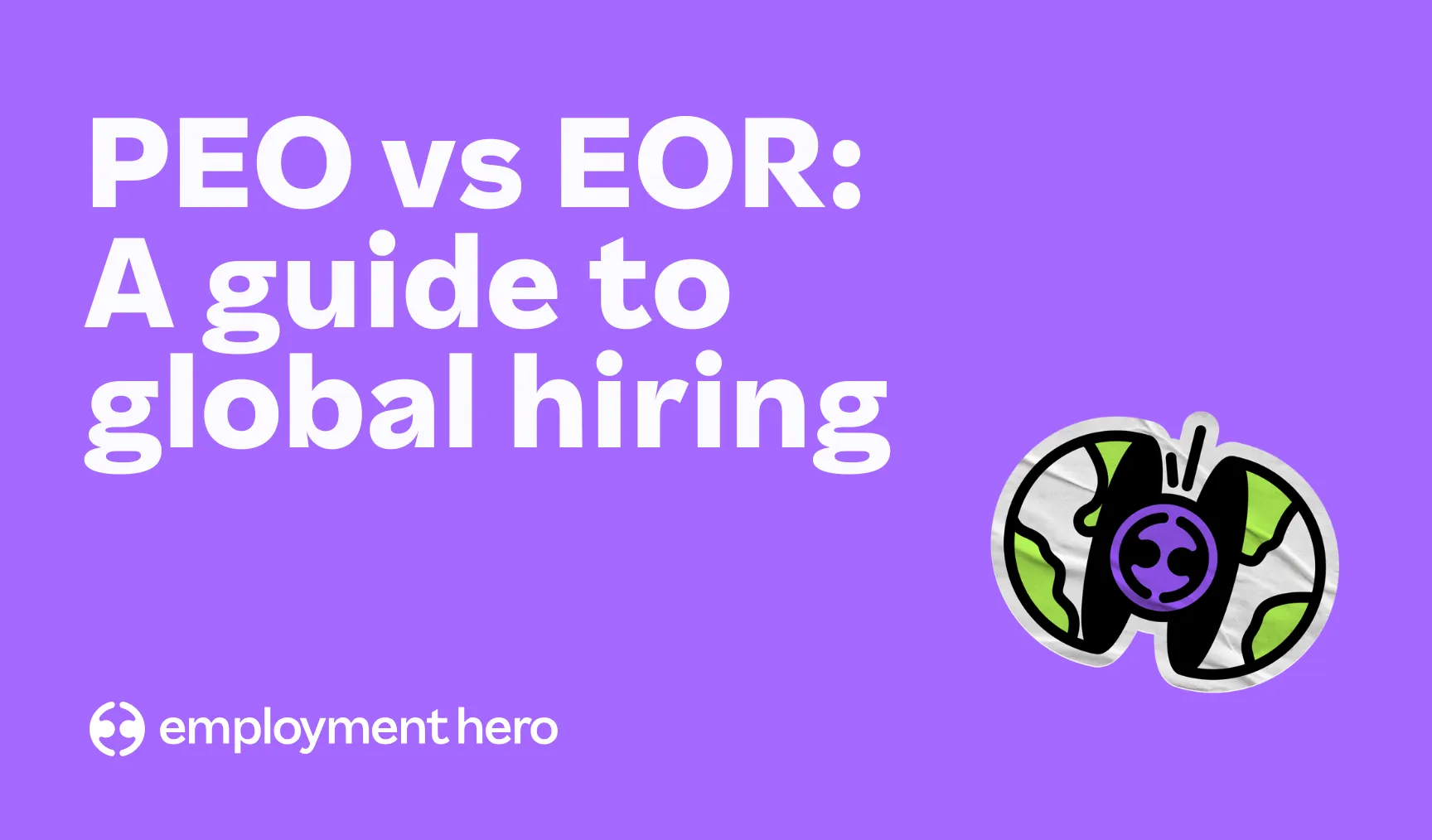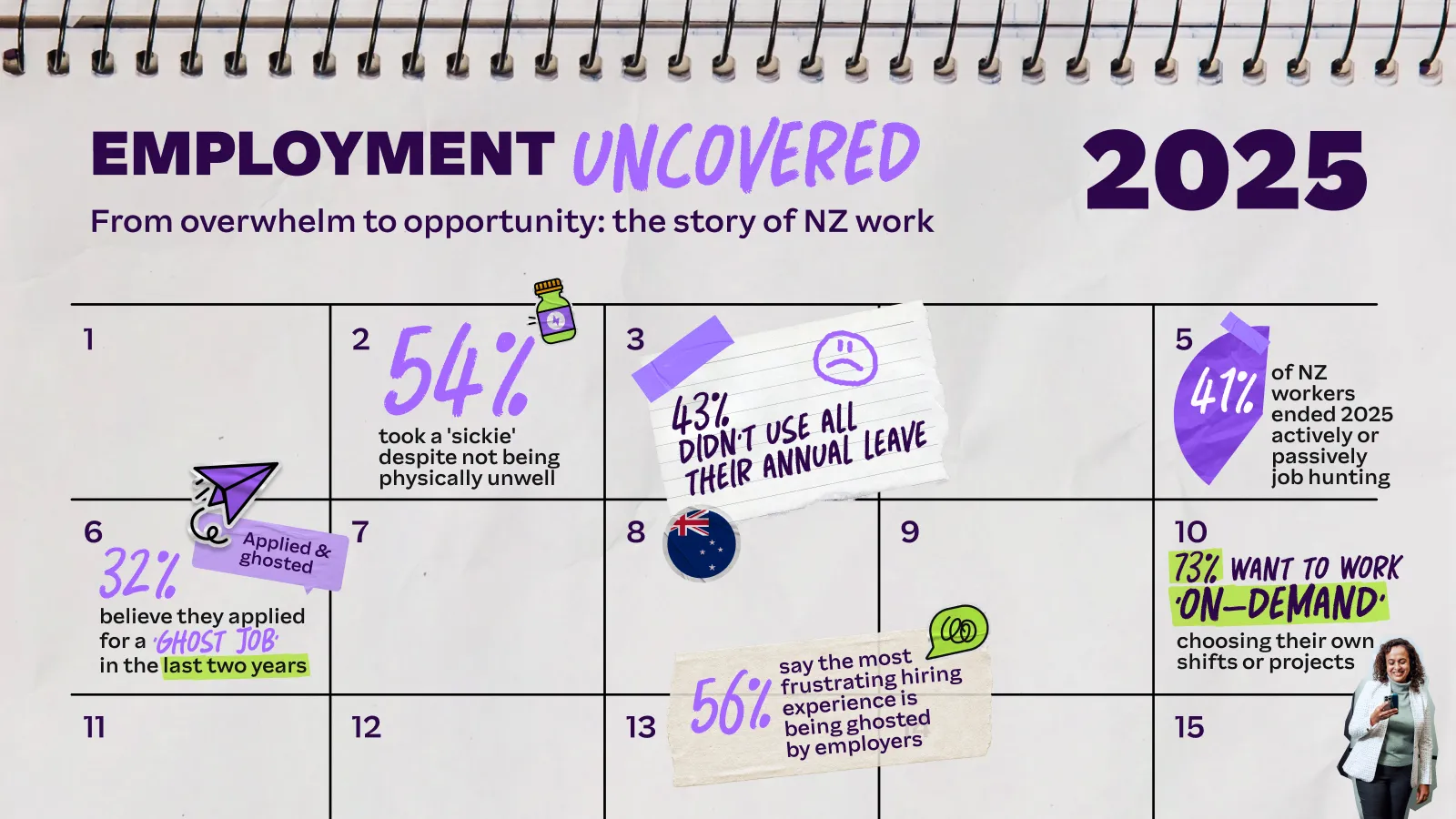Understanding accrued leave in New Zealand
Find out how leave accrual works, as well as how to calculate holiday pay in final pay.

There are plenty of terms and descriptions to get your head around when running payroll. One such example is in leave management, where calculations of accrued and advanced leave can be tricky to understand.
We’re here to break down the types of leave you need to be across, as well as how annual leave is calculated throughout employment and what to do with those leave balances if an employee exits your organisation.
Types of leave in New Zealand
All employees in New Zealand, regardless of whether their role is full-time, part-time or casual, are entitled to the following types of leave. The only exception applies to employees in the Armed Forces.
Annual leave
Employees are entitled to four weeks of annual leave after 12 months of continuous employment for a single employer. This type of leave is sometimes accrued – we’ll get to how that works later.
In limited circumstances some employees may be paid holiday pay at the rate of not less than 8% of their gross earnings with their regular pay instead of being provided with four weeks’ annual holidays each year. This is if the employee works so intermittently or irregularly that it is impractical for the employer to provide them with four weeks’ annual holidays.
Public holidays
Employees get a paid day off on public holidays if it’s otherwise a working day for them, and are entitled to a maximum of 12 public holidays a year. If they have to work a public holiday due to stipulations in their employment agreement and it is an otherwise working day for them, they are entitled to an alternative day off.
Sick leave
Employees can use up to 10 days of paid sick leave per year, provided they’ve worked for the same employer for at least six months, or if they have worked for the employer for six months for:
- An average of 10 hours per week, and
- At least one hour in every week or 40 hours in every month.
Bereavement leave
Employees who have worked for an employer for at least six months can take up to three days of bereavement leave in the event of an immediate family member’s death, or one day for other bereavements. Workplaces will often volunteer more, depending on the situation.
Parental leave
Parental leave entitlements in New Zealand can vary depending on whether the employee meets certain eligibility criteria, and if they’re the primary carer or partner. Check out our explainer here for the full details.
Family violence leave
Employees affected by family violence can take up to 10 days of family violence leave and ask for short-term flexible working arrangements for up to three months. To be eligible, they have to have worked for their employer for at least six months.
Other types of leave
There are a number of types of leave that may apply, depending on the situation and the company itself. That includes stress leave, garden leave, leave without pay, long service leave and birthday leave. These are not legally required but can be offered by the employer.
How accrued leave works
Accrued leave in New Zealand typically refers to a type of annual leave that is earned over the course of employment. There is no mention of accrual in employment legislation – but it’s a common process for employers when they are monitoring the amount of leave an employee is entitled to.
Annual leave goes through phases in an employee’s time at work. Depending on when they choose to take the leave and what their current leave balance is, they could be using accrued leave, entitled leave or advanced leave.
Accrual rate
The legal minimum entitlement for annual leave in New Zealand is four weeks per year for full-time and part-time employees.
Starting accrual
Employees usually begin accruing leave from their first day in the role, but they are not entitled to use that leave until they’ve completed their first 12 months with the employer.
Once they have reached the 12 month anniversary of their employment, the total accrued leave becomes entitled leave, and the accrual balance starts again from zero.
For example, a full-time employee who has worked their first full year for an employer without taking any annual leave will have an entitled leave balance of four weeks on their anniversary. They will then be able to use that entitled leave the following year.
Advanced leave
For most new employees, it’s fairly unlikely that they’ll go the full first year of employment without taking some annual leave. In that case, if they want to take leave it’ll have to be advanced leave. This kind of leave is in advance of their next year’s entitlement.
For example, if an employee was to take five days leave in their first year of employment, when their anniversary rolls around they would have accrued 15 days annual leave, instead of 20 days. That will leave them with 15 days entitled leave to use in the next year.
This same scenario applies to employees who are past their first year anniversary but who have used up all their entitled leave for the year. In that case, they would take advanced leave, to be taken off the following year’s total accrued balance.
Recording accrued leave
It’s important for employers to note that all leave accrued, taken and paid out needs to be recorded, and those records should be kept safe and accessible for seven years. This is crucial for compliance with the Employment Relations Act 2000 and the Holidays Act 2003.
Employment agreements
This structure of leave entitlements, accrual and expenditure doesn’t necessarily apply to everyone. There may be special circumstances, such as in collective employment agreements or individual agreements, that affect annual leave entitlements.
As an example, if an employee is on a short-term fixed-term contract, or they work so intermittently that makes it impossible for the employer to provide them with four weeks of annual leave, they may agree to be paid annual holiday pay with their pay. This is known as pay-as-you-go holiday pay.
If you’re unsure what applies in your situation, seek professional advice.

How to calculate leave in final (termination) pay
If an employee is leaving your organisation, they must receive their final wages and holiday pay in their pay for the final period of employment. This applies to any employee, regardless of their reason for leaving their role. Figuring out holiday pay can be challenging, as it varies by the type of leave taken and accrued. Here’s how it works…
Calculating annual leave
The amount that an employee receives for remaining annual leave in their final pay depends on when their employment ends. If the employment ends before the employee is entitled to annual leave (ie. before 12 months of employment for a full-time worker) the employee gets an annual holiday payment of 8% of their gross earnings, less any amount the employee has been paid for:
- Annual holidays taken in advance.
- Annual holidays on a pay-as-you-go basis..
If the employment ends after the employee is entitled to annual leave, the employee is paid for any remaining annual leave they are entitled to. This is paid at the normal rate, as if the holidays were being taken at the end of employment. The employee is also given an annual leave payment of 8% of their gross earnings since their last anniversary date, less any amount the employee has been paid for:
- Annual holidays taken in advance.
- Annual holidays on a pay-as-you-go basis.
Calculating public holidays
Some employees may be entitled to be paid for public holidays that occur after their employment has finished. This happens when the employee has unused annual leave that they’re entitled to. It doesn’t apply for employees who haven’t yet completed 12 months of employment as they haven’t yet become entitled to any leave. To determine if an employee is eligible for paid public holidays occurring after their employment has ended, follow these steps:
- Treat any remaining annual holidays owed to the employee as if they were taken immediately after the termination of their employment.
- The employee should receive payment for a public holiday if it meets the following criteria:
- It falls within the time frame created by adding their remaining annual leave to the end of their employment.
- It occurs on a day that the employee would have normally worked if they were still employed.
- If the employee is entitled to payment for a public holiday, the duration covered by the annual leave is extended by one day for each public holiday they are entitled to be paid for.
- This newly extended period may include additional public holidays that also need to be considered for payment.
- Payment for any public holidays is calculated using the standard method, based on the relevant daily pay or average daily pay (if applicable) for that day.
If the employee has previously worked a public holiday and still has an untaken alternative day off, that alternative day should be paid out as well. Any unused alternative leave that is paid out is based on the employee’s last day of employment i.e. the employee may normally work 8 hours per day but on their last day of employment they only worked 4 hours so the alternative leave only has to be paid for 4 hours.
Sick leave and bereavement leave
There is no legal requirement for employers to pay out unused sick or bereavement leave when an employee exits their organisation. However, some employers may choose to pay out some or all of the employee’s unused sick leave entitlement.
Example: A final payment including multiple leave types
Jason finishes work on Friday 16 October. Jason has been paid up to Tuesday 6 October. He has three days’ unused alternative holidays and is entitled to four weeks’ paid annual holidays. He last became entitled to annual holidays on 25 June. Jason’s final payment is made up of:
- His pay for the period worked since the previous pay period, (eight days’ pay for Wednesday 10 October through to Friday 16 October).
- Payment of four weeks’ annual holiday pay calculated at the rate of the greater of ordinary weekly pay or average weekly earnings.
- Payment for his three accrued alternative holidays for working on Friday 16 October at the rate of relevant daily pay or average daily pay (if applicable).
- An additional day’s payment for Labour Day at relevant daily pay or average daily pay (if applicable). This is because it falls during the four weeks’ notional annual holidays extension added to the end of his employment to reflect annual holidays entitlement owing.
- 8% of his gross earnings since 25 June.
These gross earnings include:
- The four weeks’ annual holidays paid out.
- The payment for the alternative holidays.
- The payment for the public holiday.
Confused about payroll? We can help.
Organising leave balances and final pay calculations doesn’t need to be a headache. Employment Hero’s Payroll Software automates your manual tasks, supports payday filing and helps you manage your payroll and leave management in one easy-to-access place. It’s payroll software made with Kiwi businesses in mind. With Employment Hero Payroll, you’ll have access to:
- Automated payroll reporting to IRD
- Automated leave balances
- Custom rule sets
- Smart payroll integrations
- Real time reporting
- And much, much more….
If you want to find out more about how Employment Hero Payroll can support your business, get in touch with one of our team today.
Disclaimer: The information in this blog is current as at 10 November 2023, and has been prepared by Employment Hero Pty Ltd (ABN 11 160 047 709) and its related bodies corporate (Employment Hero). The views expressed in this blog are general information only, are provided in good faith to assist employers and their employees, and should not be relied on as professional advice. The information is based on data supplied by third parties. While such data is believed to be accurate, it has not been independently verified and no warranties are given that it is complete, accurate, up to date or fit for the purpose for which it is required. Employment Hero does not accept responsibility for any inaccuracy in such data and is not liable for any loss or damages arising either directly or indirectly as a result of reliance on, use of or inability to use any information provided in this guide. You should undertake your own research and seek professional advice before making any decisions or relying on the information in this blog.
Related Resources
-
 Read more: PEO vs. EOR: A guide to global hiring
Read more: PEO vs. EOR: A guide to global hiringPEO vs. EOR: A guide to global hiring
Learn the key differences between a PEO and an EOR. Discover why an EOR is the smarter, safer way to…
-
 Read more: How to build a global team without a local entity
Read more: How to build a global team without a local entityHow to build a global team without a local entity
Learn how to streamline your hiring and expand your NZ business globally with an Employer of Record (EOR) without the…
-
 Read more: Employment Uncovered: Inside the Story of New Zealand Work in 2025
Read more: Employment Uncovered: Inside the Story of New Zealand Work in 2025Employment Uncovered: Inside the Story of New Zealand Work in 2025
Inside the story of NZ work in 2025. From rising ‘sickies’ to hiring fatigue, see how Kiwi work patterns are…























